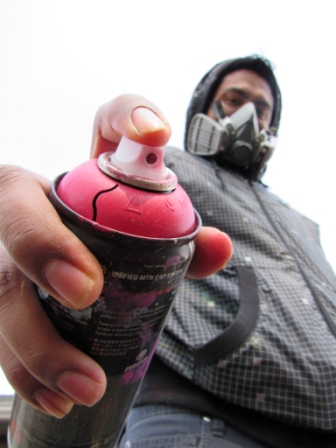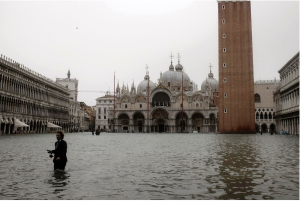Beyond the Tag
How Mexican graffiti artist Yekor became a Bayonne muralist
May 19, 2015
Mexico City, 1998 : The peach four-story apartment is a picturesque addition to a neighborhood mostly made up of small plain-colored houses.
On the first floor, open oval-shaped doorways connect the rooms. The cold walls are made of brick. The furniture is scarce, mostly small, save for a plush sofa couch in the middle of the living room. Fresco bottles line the floor of the kitchen. A small radio blasts rancheros. The father, a self-employed construction worker, is out on a job. The mother, a housewife by choice, has been up for hours despite the time. The son, a young man, is awkwardly sprawled in bed. His room is at the center of it all, sandwiched by that of his sister’s and parent’s.
“Lenin! La regadera ya se va acabar y no a ver agua!” (Lenin! The gas is going to run out and there won’t be any more hot water!), mother again.
His name is Nestor Lenin Uraga Guevara.
He hears the water cascading from the showerhead – with great force at times and others, barely dripping out as the pressure varies. He lazily struts across the hall to fill the void, passing the gallery he’s created on the wall of half-finished caricatures and bubbly letters that read like hieroglyphics to his parents. His mom thinks it’s a hobby. Even asks him to paint something by her garden.
He does, flowers mostly.
It’s a school day. Instead of a notebook, spray canisters jangle about in his backpack, a Ziploc bag filled with different-colored nozzles, and a half-face respirator mask. He waves his mother goodbye to head out and practice his real hobby.
You see it as graffiti, but not Nestor.
“Personally for me, it’s a technique and I love it. I feel more free, more satisfied with the can,” he tells me.
The origin of this freedom began with TDK (Tenemos Demasiado Kaka), Nestor’s crew – the name referring to their endless arsenal of ideas. On occasion they set out for a bomba or bombapiesa. The flashy piece of large letters spread their name, which added to their street cred: five-man job, easy.
At 14, Nestor was just beginning to treat the shabby landscapes of his barrio like a canvas, splaying “Yekor” (a play on Joker) on empty freight carts, blank muros, billboards, abandoned cars, and frankly, anywhere else he could.
He was adopted into his crew as a teen. The few, of the many, members he recalls include Eric known as “Arte,” his girl-cousin Sarai who tagged “Neah,” Tony called “Belak”; and the youngest, Sergio, who gave himself the handle Cops after the Spike TV show.
25-year-old Jorge, the oldest known as “Trom,” taught Nestor how to detail his work, use an airbrush, and manipulate the pressure of the air, how to hold the can properly, and how to shade. For a veteran, he wasn’t cocky.
The often-despondent moments of his teenhood were spent with TDK. They drank, got high, sometimes both.
With the act of carrying out graffiti came the chance of incarceration. Nestor says having been arrested 7 times is a mere fraction of the truth. Police officers, or pigs as he referred to them, would normally take a bribe in exchange for letting him go.
Now, as he sits across from me flipping through a half-filled green chewed-up album with photos of his art murals/objects of vandalism he finds that word, fraction, could also be applied to the amount of work he still has evidence of. A mere 22 of the hundreds. “This is nothing,” he says, as he flips to the empty voids of the latter pages.
But this “nothing” is his resume.
Since he moved to Bayonne a decade ago he’s touted it at fanciful art curators in New York City to display his work or even host his own gallery. But he’s been met with rejection: “They ask me for a CD of my portfolio, college background, references, and I don’t have that …so it’s frustrating.”
That frustration is weighed down further by the fact he finds that his technique is often looked down upon as “not real art.”
“Graffiti is one of the few tools you have if you have almost nothing. And even if you don’t come up with a picture to cure world poverty you can make someone smile while they’re having a piss.” ― Banksy, Banging Your Head Against a Brick Wall
With a baby-face and youthful air, Nestor seems younger than he is. Even dresses like he used to, he says.
While growing up in Mexico, he often wore a rip-off Nike sweatshirt and authentic DC skateboard shoes he bought at Tinguis (a black-market that set up shop on a twelve-block span near his house on Sundays). He has two piercings on his face, one above his right eyelid and another under his lip – which were done by a friend in a vacant classroom when he was in junior high school because “why not?”
The piercings add to the image of someone who has often been disbanded by others, labeled a rebel simply by his appearance.
He says that once, after being caught spray-painting (what was unbeknownst to him) a federal building on the outskirts of town, an officer started to chase him. Without warning, bullets started to fly.
“I mean police in Mexico are crazy,” he, now 30, says while laughing.
Then, 17, he wasn’t laughing. Instead with sweat trickling from his head as he sprinted through the gritty streets of the city, he was catching. Catching the last bit of sun before the few-functioning streets lights would flicker on. Catching from his peripherals “el puerco” (the pig) turning the corner. And finally, catching his breath.
“I turned around and he was aimed at my legs…but I kept running.”
He survived that debacle, and a dozen others like it. And even though he loved the adrenaline it provided, even as a young man he had plans beyond graffiti: evidenced by his attempt to gain admittance to the top university in the country. The open exam to become a student at the National Autonomous University of Mexico (UNAM) happens twice a year – in February and June.
He didn’t yearn, more like entertain, earning a degree to back up his ability to create.
A button-downed 19 year-old Nestor entered the cold hospital-like halls of the local high school. He took inventory of the thousands of others like him. Over a dozen schools like this in the city and each hosting a test for a specific major. He felt, frankly, that his chances were slim.
U.N.A.M is Everest – more difficult to get into than Harvard.
In July 2012 as the university celebrated 100 years, ex-Mexican president Felipe Calderon (who served from 2006 to 2012) admitted to El Universal Nacion that he himself was rejected from the school as a young man.
Nestor suffered the same fate, he was rejected. It was a mountain he would never climb. “I was trying to get into graphic designing but it was too hard,” he says.
Instead, he attended the University of the State of Mexico majoring in industrial design – the closest thing to art he could find. After a couple of months, he dropped out.
He experienced something similar when first looking for work after arriving in the United States.
His first job was at The Bust Stop Restaurant on 135th Street, a diner like the many in uptown Manhattan, where Nestor was on his feet for ten hours a day six days a week: earning $4.50 an hour.
It’s 2005 and stacks of dishes are piled before him in the washroom of a kitchenette. The motion has been chiseled into his brain to the point that even if he stopped, his hands would continue. Grab, soap. Grab, rinse. Grab, stack.
Another apron-wearing man swings by with a cart to take the crates as they fill with plates. Soap is often still seen caking at the bottom of the rack but the 20 year-old Nestor is not fazed.
The bustling streets of the Big Apple are replete with tourists who don’t comprehend the concept of a tip, middle-aged fine-arts graduates with little to show for their Broadway aspirations, homeless passerby’s with discolored styrofoam cups and Nestor, washing all their dishes.
After a month as a dishwasher, he quits.
“At the beginning it was hard, I didn’t want to stay. But then I came to Bayonne and I got used to life here,” he says.
–
He then entered a new trade.
As an unofficial freelancer in the mural market, jobs don’t come easy for Nestor. Facebook and word-of-mouth are his PR – and the language barrier doesn’t help.
On one of his first of gigs, he found himself at El Aguila Dorada – a Mexican Restaurant in Bayonne where relics of Nestor’s native-country are mounted on the walls giving customers the traditional “Mexican” experience they crave for. He was here on talks that the owner hoped to add a mural of an Aztec warrior to complete his theme.
On this day, Nestor had competition.
He, a waiter at The Chandelier Restaurant also in Bayonne (“still had to pay the bills”), charges $200 for the mural while the other party says he’ll do it for free.
He was turned down. But making it clear that his art was worth something meant more to Nestor than getting the job.
“At the end when (the other artist) finished it, the owner called me in and said ‘How do you like it?’ and I said you want me to be honest to you or you want me to lie?’ He said ‘no be honest,’ I said ‘It looks horrible,’” Nestor recalls.
“I went closer to the mural and I counted the toes on the girl (in the piece).”
“She had six.”
The owner then asked Nestor to correct the toes but no, he would only do the mural if it meant re-doing it from scratch. After the owner gave in, Nestor got to work and within a week added the final touches to the piece, lastly spray-painting his tag at the corner: YEKOR.
More than elated by the outcome, the owner paid Nestor $500 – a glimpse of the prospects this vocation could offer him.
In Bayonne, he’s done about 10 murals including work for Classic Skate Shop, florist Angelina’s Mum, a mural at the 16th Street Park, and was the lead artist on the dedicatory mural of Bayonne-native and boxing legend Chuck Wepner, who faced off against Mohammed Ali in 1975.
Each mural showcasing his abilities – primarily for expression but also working as unofficial ads so others could commission him as well.
Some of the skills he uses today when creating murals, he mostly learned while doing “legal graffiti” (getting permission from residents to paint on their wall or work for organizations) in Mexico in his late teens – between 17 and 19 and just prior to coming to the U.S.
Exhibit A: his political graffiti. More precisely, a bandana-wearing, horse-riding, pipe-smoking vigilante with the nom de guerre of Subcomandante Marcos. Marcos, a political writer and anti-capitalist, was recognized as a leader in the fight for the human rights of Mexico’s indigenous people. In 1994, the then Sub-commander Marcos led an army of Mayan farmers into the eastern Chiapas state to rally against the government’s mistreatment of the indigenous people.
“I myself didn’t know we had that many indigenous in Chiapas and the government were taking everything away from them,” Nestor says of seeing the reincarnated Marcos as a teen, “so we started protesting, and I (started) doing that with my graffiti.”
After taking a moment to scroll through a mental archive, two pieces stand out in Nestor’s memory.
In the first, he turned a popular news story about a Mexican politician, who held the position of Head of Government of the Federal District from 2000 to 2005, into a political cartoon. Head of Government, Andrés Manuel López Obrador, had recently made headlines for the discovery that he was paying his driver an ungodly amount of money (we’re talking $1,300 a day). This, while the poor were starving on the very streets Obrador’s limousine traversed on a daily basis, Nestor said.
Nestor, armed with a spray can, set out to highlight the obscenity of the news story with his own brand of humor – a cartoon was fitting:
A stretch limousine and the driver blinged out with a 24-karot Rolex,
Shimmering gold necklace,
and
a pinky ring.
Ordinary citizens hollering and raising their arms.
Obrador holds a chubby stack of bills and smiles exposing his gold teeth.
Nestor also protested alongside Marcos at Los Pinos (the home of the president very much resembling The White House both in significance and appearance) one afternoon around the time he hoisted up yet another piece:
An indigenous woman holding her infant
The baby is dreaming of milk and crying
Mexico’s ex-president Vicente Fox is dressed as Don Quixote
with the secretary of government as Sancho Panza
A word bubble reading,
“Pancho, si los perros ladran, es porque vamos avancando”
(If the dogs bark, it is because we are advancing.)
“The message was that Fox was treating the indigenes like dogs,” Nestor explains.
According to Minority Rights Group International, an internal non-governmental organization, Mexico has one of the largest indigenous populations in the world with 12.7 million indigenous people.
He took action against a number of other causes in his country and began to notice that with age came less and less tagging of TDK and more detailed murals with a message beyond that of making a name.
Today, instead of defacing billboards, he’s bringing new life to empty Bayonne walls. No more hopping fences to escape the cops and more taking double shifts serving tables to help pay his rent. His most recent political work? An art piece he was inspired to do by his Ukrainian ex-girlfriend about the war plaguing her country:
A peace symbol and “fight the power” fist embedded over it with the blue and yellow of the Ukrainian flag
–
Being an adolescent during his graffiti days, Nestor was always in some way absolved from crimes that as an adult, would’ve meant much more serious consequences. On more than a few occasions he sat in the officer’s quarters of a Mexican prison serving his minor offense charge of 24 hours for criminal mischief –
which were nothing compared to thousands of pesos and years in jail: “I knew I had to turn my life around, and it was starting to happen already…slowly.”
As he began to undergo changes in his life, Nestor realized he learns best when immersing himself into environments.
It’s how Nestor learned to create art; not throughout courses but by hanging out with TDK and practicing his craft sometimes according, sometimes against, the law. It’s how he learned to speak English: not through schooling or educational videos, but by working in Bayonne restaurants where the chatter was entirely English and watching “The Simpsons” with the subtitles turned on.
He absorbs knowledge like a sponge. More than a quarter into his life, he says what he has learned thus far has taught him a lesson about art.
Put simply, it’s something beyond a degree: “There is a lot of good artists, but some of them they just learn from school and they don’t feel it inside their bodies, you can learn the technique and everything, you can learn how to paint but you can never learn how to express yourself,” he says before revealing that he will soon look to return to school.
“Not for me,” he says before pausing, “but for them.”













